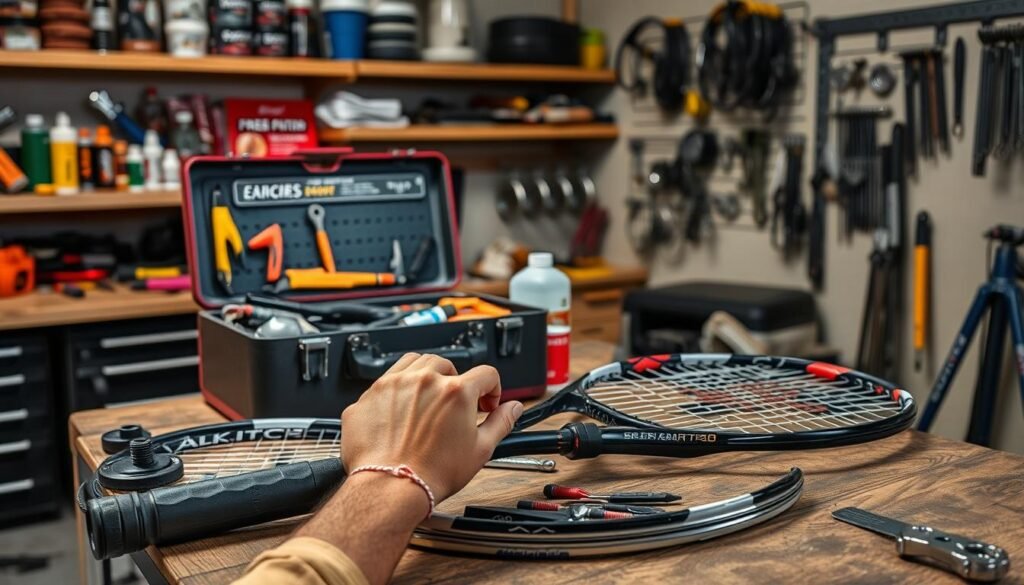Ever wonder why some athletes consistently perform at their best while others struggle with frequent gear failures? The secret often lies in proper care. Keeping your gear in top shape isn’t just about safety—it boosts performance and saves money.
Studies show that regular upkeep can reduce injuries by 18% and extend lifespan by 40%. Whether you’re a weekend warrior or a pro, neglecting your gear risks both performance and health. Proper storage, cleaning, and inspections make all the difference.
NCAA reports reveal 23% of injuries stem from faulty gear. Simple routines, like climate-controlled storage and timely repairs, prevent mishaps. Investing time in maintenance now means fewer replacements and higher resale value later.
Key Takeaways
- Proper care cuts injury risks by 18%.
- Regular upkeep extends gear life by 40%.
- 23% of sports injuries come from poorly maintained equipment.
- Climate-controlled storage preserves quality.
- Consistent maintenance saves $300–$500 yearly.
Why Proper Sports Equipment Maintenance Matters
Gear failures cost athletes more than just money—they risk performance and safety. A single flaw in critical items can lead to injuries or lost games. Investing time in care pays off in durability and results.
Extending the Lifespan of Your Gear
Composite materials degrade faster without care. For example, tennis racquets lose tension 30% quicker without restringing. A simple way to avoid this saves players $300 yearly.
Ensuring Safety and Peak Performance
Cracks or worn padding increase damage risks. Hockey gear with regular checks lasts 5+ years versus 2 years when neglected. Proper care keeps you safe and competitive.
Preventing Costly Replacements
Replacing hockey gear averages $800—versus $150 for annual upkeep. Proper inflation alone cuts ball replacement cost by $120/year. Documented maintenance can even lower insurance premiums.
How to Maintain Sports Equipment: Foundational Principles
Top athletes know that consistent performance starts with well-kept gear. Three habits—cleaning, storage, and inspections—form the backbone of regular maintenance. Ignoring these risks premature wear and costly replacements.

Regular Cleaning to Remove Dirt and Sweat
Sweat and grime accelerate wear tear. Use mild soap for helmets and pads. For composite materials like racquets, avoid harsh chemicals that degrade coatings.
Microfiber cloths prevent scratches. Air-dry items completely to stop mold growth. A 10-minute post-use wipe-down doubles gear lifespan.
Proper Storage to Avoid Environmental Damage
Humidity warps wooden bats and rusts metal components. Store gear in climate-controlled spaces below 70°F. Use silica gel packs for moisture-sensitive items like inflatables.
Hang wet items on ventilated racks. Never leave gear in direct sunlight—UV rays weaken fibers and adhesives.
Routine Inspections for Wear and Tear
EZOfficeInventory’s 30-point checklist cuts repairs by 45%. Check for stress fractures in carbon fiber or frayed seams in inflatables. Tighten loose fasteners to manufacturer torque specs.
Analyze footwear soles for uneven signs wear. Replace if treads fade below 50%. Document findings to track degradation patterns.
Cleaning Techniques for Different Sports Gear
Different gear requires unique cleaning methods to stay in top condition. Dirt, sweat, and grime can degrade materials, increasing the risk of injuries. Tailoring your approach ensures longevity and peak performance.
Balls and Inflatable Equipment
Soccer balls and basketballs need gentle care. Use mild soap and warm water to remove dirt. Avoid harsh chemicals that can damage seams or coatings.
Check for punctures after each use on the field. Store inflatables partially deflated to reduce stress. Silicone-based sprays help maintain grip and elasticity.
Rackets and Bats
Tennis racquets and baseball bats collect sweat and dirt. Wipe grips with a damp microfiber cloth. For composite frames, avoid abrasive cleaners to prevent scratches.
Inspect strings or tape for wear. Frayed areas increase the risk of breakage during play. Regular cleaning preserves balance and responsiveness.
Protective Gear
Helmets and pads need thorough cleaning to ensure safety. Use antimicrobial wipes on padding to prevent odor and bacteria buildup. Straps lose elasticity over time—replace if stretched.
Follow NOCSAE standards for recertification every two years. EPS foam must pass compression tests to absorb contact impacts. Always check certification stickers for validity.
Best Practices for Storing Sports Equipment
Storing gear correctly is the silent hero of peak athletic performance. The right methods prevent damage and boost longevity, saving time and money. Whether it’s a humid garage or a dusty closet, smart storage solutions matter.
Climate Control and Humidity Management
Moisture warps wood and rusts metal. Keep spaces below 70°F with 50% humidity. Silica gel packs absorb excess dampness in bags or cases.
For gear like inflatables, avoid attics or basements. These areas fluctuate in temperature. Climate-controlled rooms preserve adhesives and fibers.
Using Racks, Hooks, and Containers
Vertical storage saves space and improves airflow. Mesh racks let wet gear dry fully. Avoid plastic bins without vents—they trap moisture.
Label containers by season or sport. Clear bins help spot gear quickly. Hanging bikes or helmets prevents dents and cracks.
Long-Term Storage Tips
Vacuum sealing extends gear life fivefold (TJ Distributors). For items stored over six months, add oxygen absorbers to prevent mold.
Use gas-permeable covers for breathability. Heavy-duty covers shield against dust and UV rays. Check gear quarterly for pests or mildew.
Sport-Specific Maintenance Guides
Specialized gear requires tailored approaches for lasting performance. Whether it’s carbon-fiber bikes or neoprene wetsuits, understanding your materials ensures longevity. Follow these guidelines to avoid damage and maximize your gear’s life.
Bicycles: Lubrication and Rust Prevention
Chain lubrication reduces friction by 30% (BikeRumor). Use wax-based formulas in dry climates and wet lubes for rain. Wipe excess oil to prevent grime buildup.
Check for rust on bolts and frames monthly. A chrome polish protects vulnerable areas. Store bikes indoors to shield them from humidity.
Gym Equipment: Upholstery and Electronics Care
Clean treadmill belts with mild soap to preserve grip. For vinyl benches, use non-alcoholic wipes—harsh chemicals crack materials over time.
Inspect cables and touchscreens weekly. Dust blocks sensors and reduces accuracy. Gym care logs cut repair costs by 22% (IHRSA).
Water Sports Gear (Kayaks, Surfboards)
Apply UV-protective wax every 60 days. It prevents sun damage to epoxy resins. Inspect hulls for deformations with a straightedge quarterly.
Replace drysuit gaskets if they lose elasticity. Neoprene glue repairs small tears instantly. Rinse gear with freshwater after each use to remove salt.
Preventive Maintenance to Avoid Damage
Training users reduces damage by 40% (Storage Guide). Small steps today prevent big problems later. Consistent care keeps gear safe and functional.

Scheduling Regular Service Checks
Monthly inspections catch issues early. Look for loose bolts, frayed straps, or worn grips. A 10-minute check can save $200 in repairs.
Document findings in a log. Track patterns like repeated stress points. This way, you spot trends before failures happen.
Addressing Minor Issues Before They Escalate
Fix small cracks or tears immediately. Delays worsen damage. For example, a $5 patch kit can save a $200 kayak hull.
Keep repair supplies on hand. Adhesive tapes and lubricants are must-haves. Proper use of these tools extends gear life.
Educating Users on Proper Handling
Create short videos showing correct practices. Highlight common mistakes, like dragging equipment. Visual guides improve retention by 70%.
Require certification tests for high-value gear. Test knowledge of weight limits and storage rules. Reduce contact damage with clear instructions.
Conclusion
Smart care keeps gear performing longer and safer. Simple routines save hundreds yearly while reducing injury risks. Data shows proper maintenance extends lifespan by 40% and cuts replacement costs by half.
Tools like EZOfficeInventory streamline inspections. TJ Distributors’ storage solutions protect against humidity and UV damage. Certification programs ensure compliance with safety standards.
Share knowledge with teammates or online communities. Collective tips boost longevity for everyone. Investing in sports equipment care today means better results tomorrow.
FAQ
Why is regular cleaning important for gear?
Dirt, sweat, and grime degrade materials over time. Cleaning prevents buildup that weakens fabrics, metals, or padding, ensuring better performance and safety.
How often should protective gear be inspected?
Helmets, pads, and braces need checks before each use. Look for cracks, loose straps, or worn-out padding to avoid injuries during play.
What’s the best way to store tennis rackets?
Keep them in a padded case away from extreme heat or cold. Loosen strings slightly if storing long-term to maintain tension and frame integrity.
Can improper storage damage inflatable balls?
Yes. Exposure to moisture or sharp temperature swings causes leaks or warping. Store basketballs and soccer balls in dry, moderate conditions.
What signs indicate a bike needs servicing?
Squeaky chains, stiff brakes, or rust spots signal trouble. Regular lubrication and part replacements prevent breakdowns during rides.
How does humidity affect gym equipment?
High moisture levels corrode metal parts and degrade electronic displays. Use dehumidifiers and wipe down machines after workouts.
Should kayaks be stored upside down?
Yes. Flipping them prevents hull deformation and reduces UV damage. Always rinse with fresh water after saltwater use.
When should baseball bats be replaced?
Cracks, dents, or a “dead” sound upon impact mean it’s time for a new bat. Composite models lose pop faster with heavy usage.



